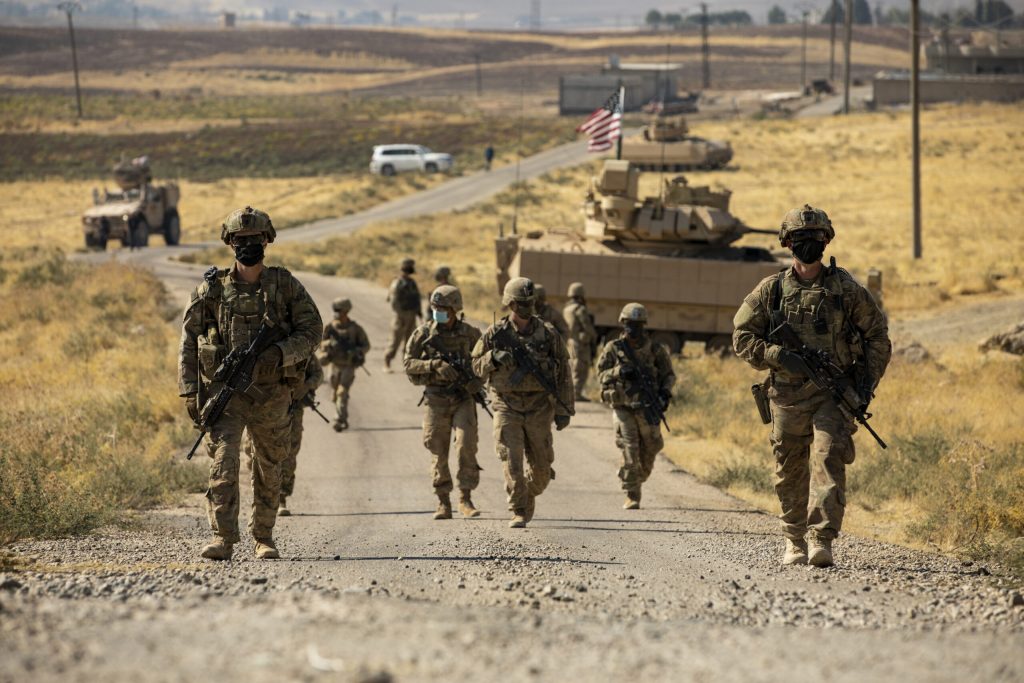
The American military presence in Syria began on 22 September 2014[1] primarily as a response to the rapid expansion of the Islamic State of Iraq and Syria (ISIS).[2] The US-led coalition aimed to degrade and ultimately defeat ISIS, which had seized large territories across Iraq and Syria, posing a significant threat to regional stability and international security.[3] Over time, the mission evolved to include support for the Syrian Democratic Force (SDF), a coalition of Kurdish and Arab militias,[4] in their efforts to dismantle ISIS’s territorial control and establish governance in liberated areas.
The US involvement in Syria has been a topic of considerable debate within policy circles.[5] Proponents argue that a continued presence is essential to prevent a resurgence of ISIS, to counter Iranian influence, and to support in practical and strategic ways regional allies. They assert that a hasty withdrawal could create a power vacuum, leading to increased instability and a humanitarian crisis. Critics of America’s continuing presence in Syria contend that the US has no clear long-term strategy in Syria and that maintaining in-country military personnel risks entangling the US in an intractable conflict with no clear endgame. Opponents of the US’s continuing involvement press for a diplomatic solution, claiming the financial and human cost of military activity outweigh its benefits.[6] The debate continues with little sign that the November election will lead to greater clarity in the US’s position on Syria.
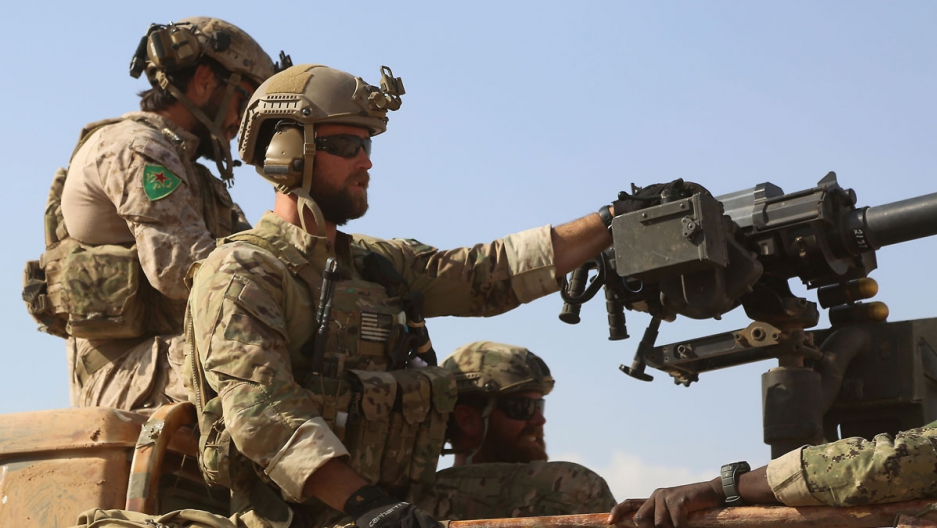
In January 2018, then US President Donald Trump (b. 1946; Pres. 2017-2021) reaffirmed the US commitment to remain in Syria to fulfil its key objectives, namely, to oust Syrian President Bashar al-Assad (b. 1965; Pres. 2000-present) and to counter Iranian influence in the region. In December 2018, Trump reversed that decision announcing the immediate withdrawal of the remaining (ca. 2000) American troops from Syria. His decision sparked significant domestic and international controversy. In a tweet justifying his decision (7 October 2019), Trump stated, ‘It is time for us to get out of these ridiculous Endless Wars, many of them tribal, and bring our soldiers home’. Adding, ‘WE WILL FIGHT WHERE IT IS TO OUR BENEFIT, AND ONLY FIGHT TO WIN.’ This announcement was met with concern by military officials and allies who feared a rapid withdrawal might compromise gains made against ISIS and return the region to instability and renewed susceptibility to ISIS attacks and violence. Despite President Trump’s October 2019 announcement, a wholescale US military withdrawal has not materialized. Some US troops have left, but a significant number remain to secure key areas and to continue to engage in, and support, counter-terrorist operations.[7]
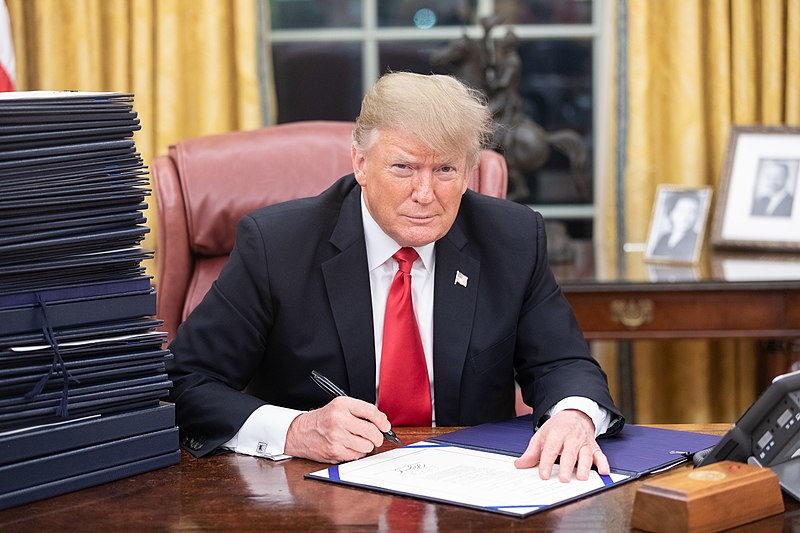
Discussion of America’s on-going presence in Syria often focusses on military strategy and the threat from ISIS, on regional political and on broader geopolitical questions. Such discussions, important thought they are, tend to overlook (if not deliberately ignore) the material plight and engaged perspective of those whose everyday lives are directly impacted by detached diplomacy and the dynamics of US indecision. We speak, of course, of the fragile, fragmented, communities of Syrians who live in areas where the US military remain. Residents here have experienced first-hand the benefits and the risks of America’s on-going involvement. Access to insights and information from these individuals and groups offers a fresh – we would argue more nuanced and authentic – perspective, too rarely found in outsider analysis and debate. This local data is invaluable, and should, we believe, be integrated in balanced (re-)evaluation of US involvement in Syria both now and going forward.
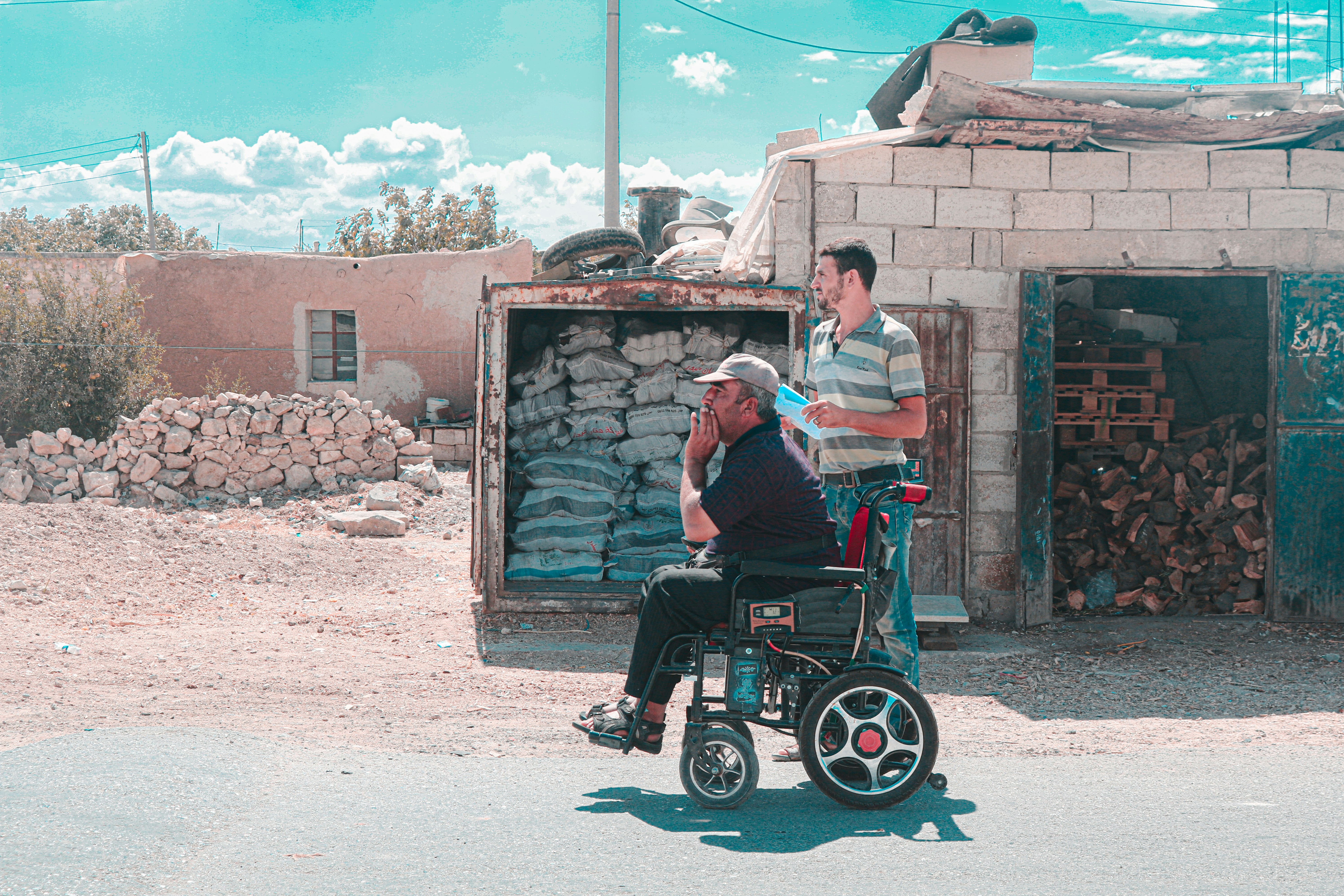
This Briefing aims to provide a grassroots Syrian perspective on US troop withdrawal, based on face-to-face and virtual interviews with residents in eastern Syria. The interviews reveal the complex interplay of security, economic, and social factors that shape regional opinions in Syria generally and in eastern Syria specifically. By enabling access to local voices, the Briefing aims to empower grassroots actors and enrich international understanding not only of the complex phenomenon that is early-21st-century Syria but also of broader issues relating to Western foreign policy in the Middle East. To synthesize a large body of material, we focus here on issues relating to security and stability, finance, Human Rights and governance.
Security and Stability
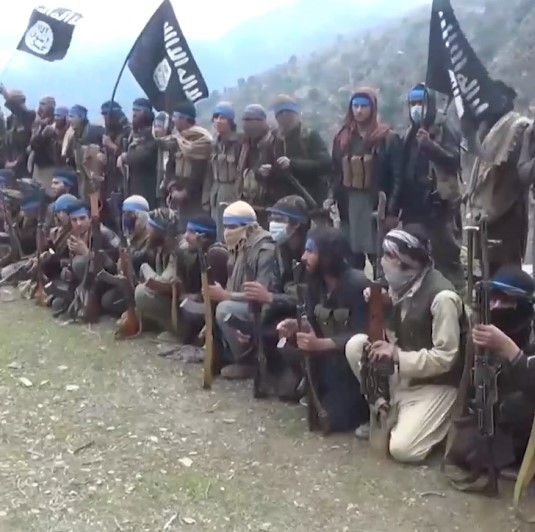
The security landscape in Syria has undergone significant change since the start of the civil war in March 2011 and the rise of ISIS.[8] Prior to the US intervention, large swathes of Syrian territory in the eastern part of the country were under the control of ISIS, which used it as a base to launch attacks in Europe and other parts of the world.[9] As we have seen, the American military presence, beginning in 2014, aimed to dismantle ISIS and restore stability in the region. The implications of the US presence have, as we have again begun to see, been complex, their impact on local security and regional power dynamics considerable.
The US-led coalition has been central to the war with ISIS. In this, it has significantly reduced ISIS’s territorial control and its operational capabilities. Many Syrians acknowledge the key role the US has played in curbing the threat posed by ISIS. As one interviewee noted, ‘Our region is considered safe because of the presence of American forces, which prevent ISIS from resurfacing in Deir Ezzor.’[10] This sentiment reflects broader recognition that the US presence has brought a measure of security to regions previously plagued by extremist violence against local tribes. Many in eastern Syria, particularly around Deir Ezzor, attribute their present, relative safety to the deterrent effect of US troops on ISIS and its sleeper cells. That ISIS is present and active few doubt, its fighters ruthlessly seeking power and terrorizing opponents.
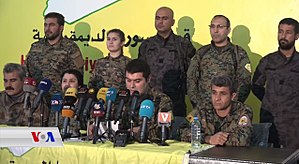
In addition to suppressing ISIS, the US presence has had a direct impact on power dynamics in the region; in particular, on thwarting Iran’s influence in eastern Syria. US forces have acted as a buffer against Iranian militias to the west of the Euphrates. This has helped to protect Syrian interests in the region. As one local we interviewed said, ‘The American presence has created a kind of balance in the local forces in eastern Syria.’ Without this US intervention, there would be little active resistance to hostile militias and less traction for political and social stability. Few interviewees denied the US military presence gave them a greater sense of security. This is particularly clear in Deir Ezzor and its environs, where residents speak of seeing significant improvement in their daily life. ‘Our region is considered safe because of the presence of American forces,’ said one interviewee. This is important. It helps to highlight the contrast locals draw between US-controlled areas and those where forces loyal to the Syrian regime (or one of a number of other factions) is in the ascendant. Where US forces are not present, fear of arrest or abuse by militias loyal to Iran or the Syrian regime prevails.
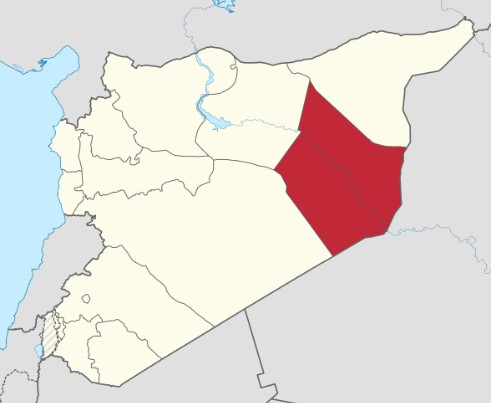
Two other points under this heading deserve notice. First, interviews with residents in eastern Syria have revealed both recognition of, and appreciation for, the way coalition forces have respected local culture and religious practices. As one interviewee said, ‘The positive thing is that the coalition forces and the Americans do not interfere with the culture of others and do not impose themselves on anyone as the Syrian regime does with people under its control.’ And, he added, ‘I study the Qur’an and find no restrictions from the coalition forces.’ Second, the US presence is also widely seen as engendering greater political and social ‘openness’ and enhancing ‘communication’ of every kind; and both of these in contrast to repression in areas controlled by the Ba’ath regime led by President Assad. As one person put it, ‘The American presence does not affect local culture because they do not interfere with laws, customs, and traditions. They are a reason for openness and provide communications. In regime-controlled areas, many mobile apps are banned and there is regular phone inspection at military checkpoints and surveillance in areas controlled by Russia, Iran, and the Assad regime.’ Critics of the US presence should note this positive response from (some) residents in eastern Syria.
Socio-economic Impact
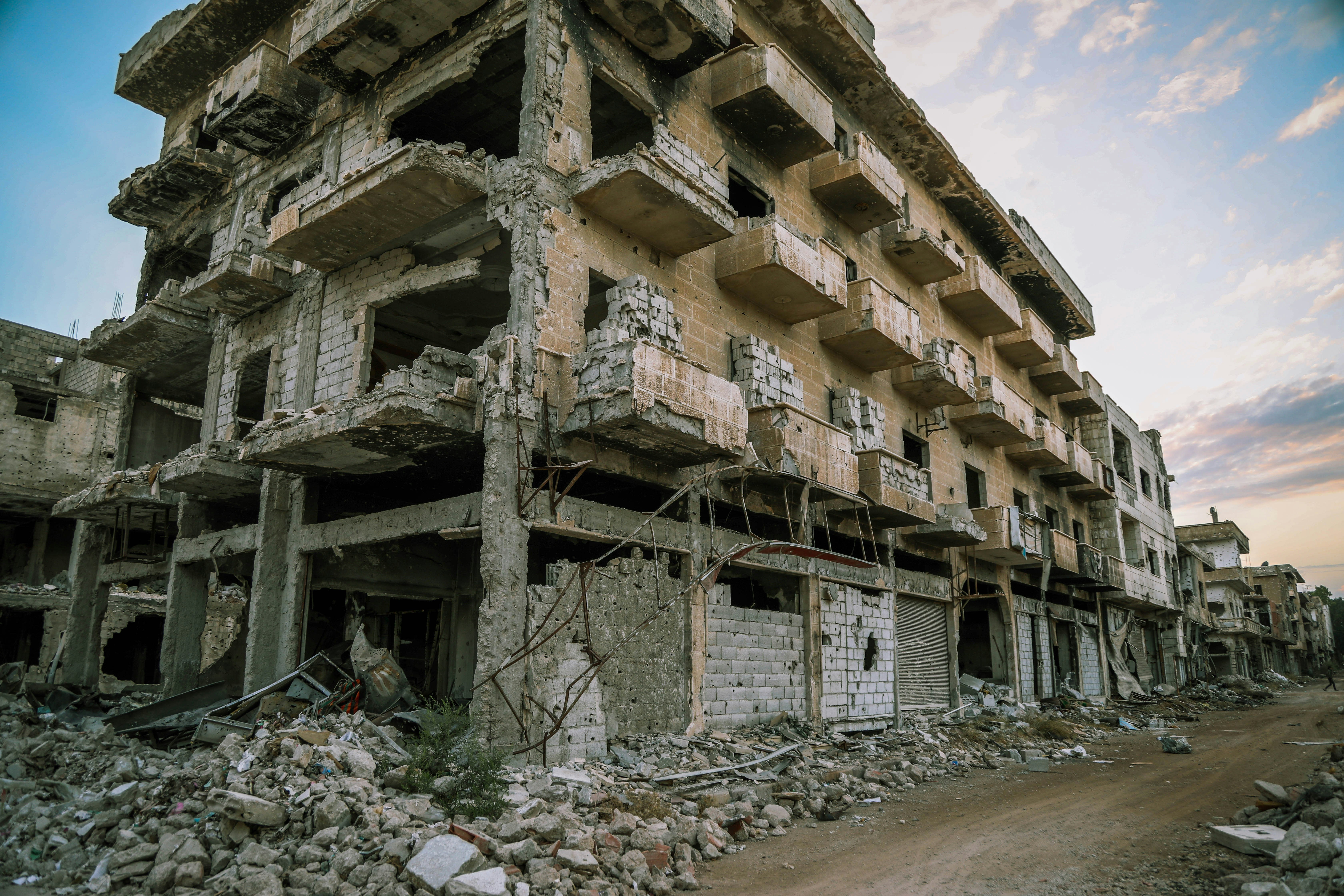
The socio-economic impact of years of conflict in Syria has been severe. The downward spiral associated with a protracted civil war has seen poverty, sickness (physical and mental), unemployment and a lack of basic services, take root. However, the US presence in eastern Syria, though primarily focused on security and counterterrorism, has had a significant impact on the economy and daily life of Syrian citizens. Positive consequences deserve notice.
First, the US presence has catalysed jobs, job opportunities and increased income levels in some sectors.[11] Economic stability and increased social mobility have been key. As one interviewee from Deir Ezzor pointed out, ‘Many people from the Deir Ezzor countryside prefer to stay in areas controlled by US forces in search of job opportunities. There are jobs and projects available, and wages are higher compared to areas under regime control.’ This sentiment reflects a broader trend where US-controlled areas have seen relatively better economic conditions.[12] The availability of jobs and higher wages has provided a lifeline for many residents who would otherwise face the impoverishment and depredation of areas controlled by the Syrian regime, where salaries are significantly lower, and opportunities scarce.
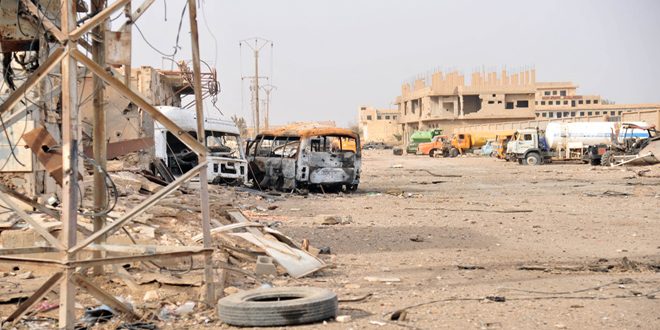
Second, the US presence has also helped to improve to a more limited extent infrastructure and basic services. Lighting has been improved in some areas and equipment provided for some hospitals, but residents are clear, more is needed. As one interviewee pointed out, ‘The impact of the US presence is primarily military; there is no significant interest in the civilian and service aspects from the Americans. There are some modest services like activating lighting and supplying some hospitals with equipment.’ Though appreciated, improvements in infrastructure and basic services are modest compared to the needs of the local population. Hence, though the US has provided more than $1.1bn on humanitarian aid to Syria ($16.8bn since the start of the civil war), many call for additional funding to create long-term economic stability and social reconstruction.[13]
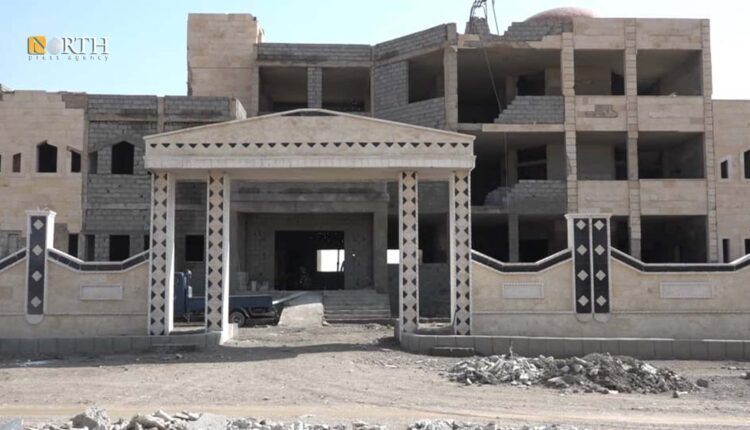
Despite socio-economic benefits in US-controlled areas, criticism and disparity abound. Some Syrians perceive US economic and infrastructure support to be unevenly distributed, with Kurds doing better than their Arab neighbours. As one resident complained, ‘The Americans support[ed] the Kurdish component and prefer[red] the Kurdish component over the Arab. There is monitoring of the Arabs, but there is no monitoring of the Kurds.’ Though enhancing peace and stability in some areas, perceived partiality to Kurds and marginalization of Arabs has stoked societal suspicion and tension. Critics inside and outside Syria find evidence here to justify their concerns, with US military objectives seen to displace humanitarian priorities. That said, while the US presence has clearly benefitted areas under its control, a more robust, holistic response to the diverse and evolving needs of the local population is now a priority.
Human Rights and Governance
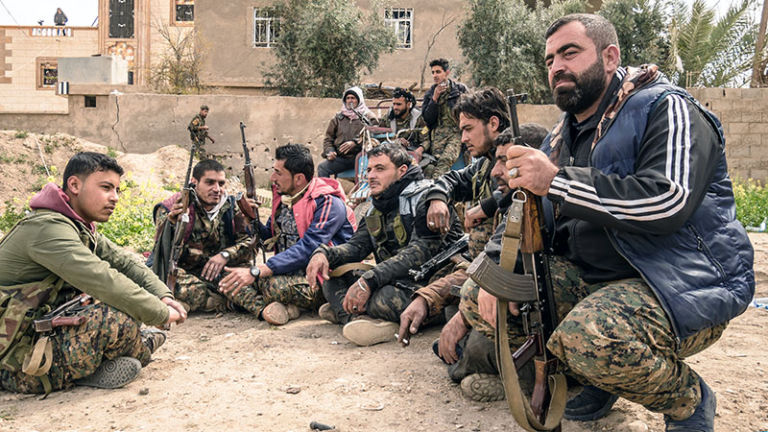
Though a military force, since the outbreak of civil war in Syria, the SDF has played a prominent role in the socio-political life of eastern Syria. This has been a source of considerable debate among residents, with many questioning the propriety, integrity, efficiency and equability of their actions. Governance structures established and overseen by the US military have shared some of the criticisms levelled against their SDF allies. Reconciling the need for stability and security and the obligations of inclusivity and even-handedness politically has not been easy.
Drilling down into this a little further, three things stand out for comment.
First, one of the most pressing issues highlighted by interviewees was human rights abuse in SDF-controlled territories.[14] Reports of torture, arbitrary detention, and mistreatment in SDF prisons are rife, causing deep concern and distress to locals. ‘Many innocent people are in SDF prisons due to torture,’ said one interviewee, pointing to a lack of accountability and investigation by US troops, despite their awareness of the issue. This is serious. Human rights concerns are a source of suffering and undermine legitimacy in local governance. Failure to address this issue has created a sense of distrust and dismay among many residents, who want the US military to take responsibility for addressing this damaging issue.
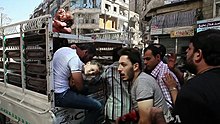
Second, linked to this, torture is also reported to be taking place in SDF prisons. As one person stated, ‘Many innocent people are imprisoned due to forced confessions obtained through torture, and they have been jailed for years without any wrongdoing. The severity of torture in SDF prisons, with the knowledge of American forces, raises questions about why there has been no investigation into the treatment of people in these prisons.’ The need to investigate these claims and hold perpetrators to account is clear.
Third, evidence suggests the quality, efficiency and integrity of local administration/s under SDF control varies widely, with many Syrians expressing dissatisfaction with the current state of affairs. Since the US and SDF work closely together, respect for the US is compromised by this. Governance is deemed biased and unrepresentative (particularly of Arab majority areas). Picking up an earlier theme, Kurdish dominance in the SDF has led to claims of favouritism and its converse marginalization. This has created intra-societal tension and conflict. As one interviewee presented the situation, ‘The Americans supported the Kurdish component and preferred the Kurdish component over the Arab.’ This is deeply problematic; particularly after the Deir Ezzor Military Council was dissolved by the SDF in August 2023 (following violence between Arab and SDF forces) and no Arab force has been formed to replace it.
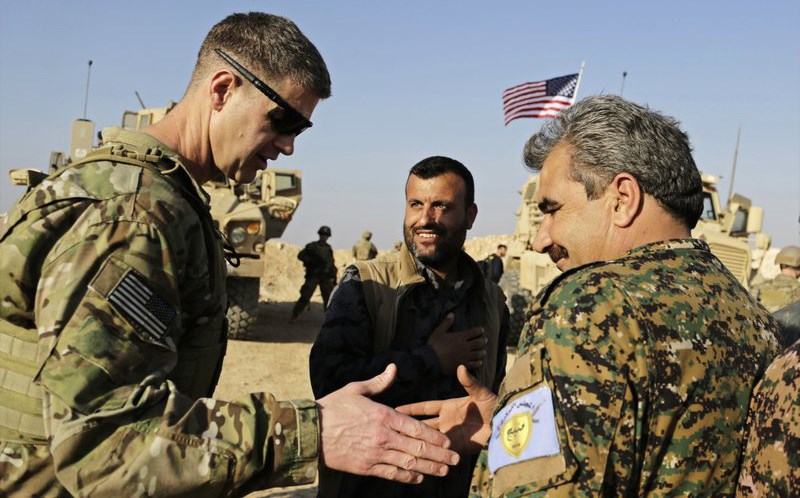
Fourth, more generally, many Syrians criticize the US military for their failure to engage directly in local affairs. This has led to a sense among many residents that the US has failed to communicate effectively – let alone fully understand – local issues. ‘The US should have representatives monitoring on the ground or at least have offices or hotlines for communication,’ one person urged, emphasizing the need for more proactive and responsive engagement. This lack of contact and oversight has contributed to a sense of abandonment by residents who believe their concerns and grievances have not been, and are not being, adequately addressed. Over reliance on the SDF is at the heart of many people’s disquiet.
So where from here?
Many in eastern Syria see the US presence as a mixed blessing. They appreciate the sense of peace and stability the US affords but are frustrated by a failure to address pressing issues around economic vulnerability and governance inequality. Despite this, the US military’s role in preventing a resurgence of ISIS is a cause of general relief. As one interviewee said, ‘The place is considered safe because of the presence of American forces, which prevent ISIS cells from reaching Deir Ezzor and halt the advance of Iranian militias.’
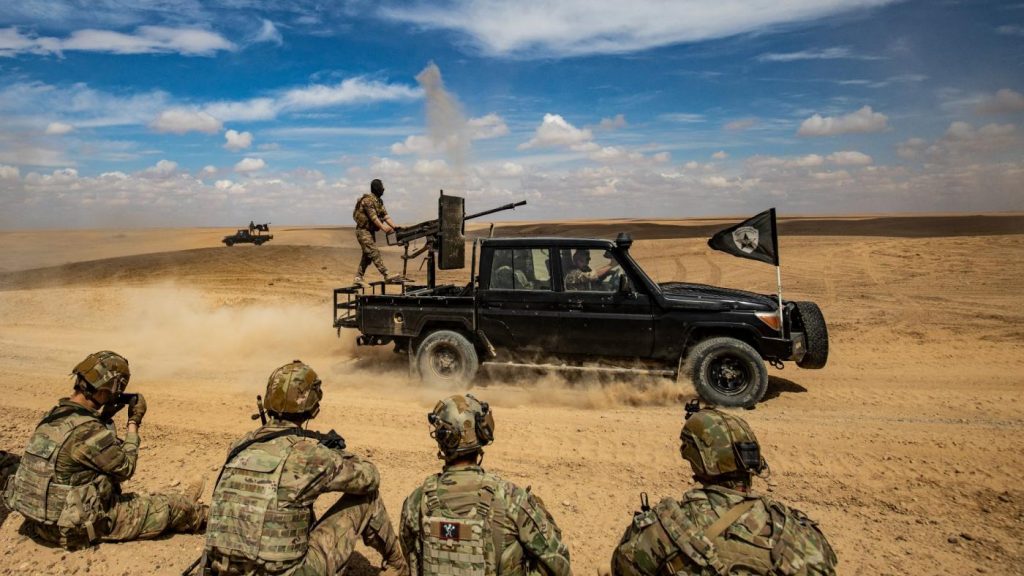
Mindful of the need for the US to be clear in its own mind about its future involvement in Syria, we suggest four issues be prioritized:
i. a clearer balance between military objectives and societal reconstruction. As we have seen, some residents feel civilian needs have been sidelined. As one local stated, ‘The impact of the US presence is primarily military; there is no significant interest in the civilian and service aspects from the Americans.’ This imbalance feeds frustration.
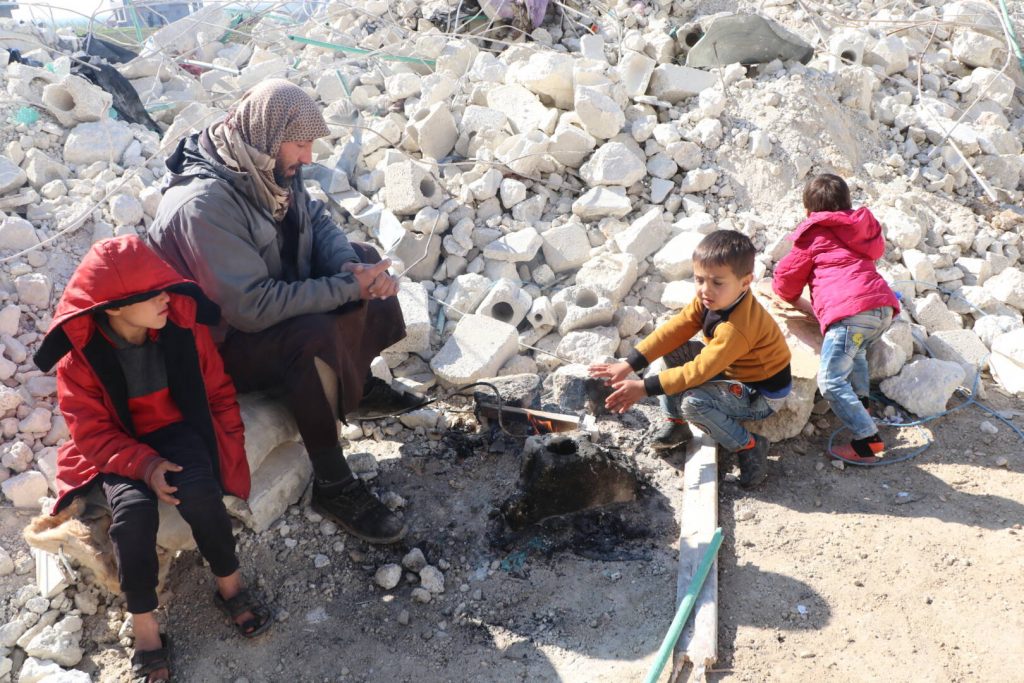
ii. a proactive and effective approach to ensure long-term stability. Many Syrians see the need for an on-going US military presence in their country; however, they want this to be linked to a larger, clearer vision of national, local and regional renewal. As one interviewee expressed this, ‘It is very necessary for American forces to remain in the region, but they must turn their intentions into real actions to establish security and stability and seriously cooperate with the local community. Continuing with the current policy will benefit the Iranian militias, Assad’s regime, and ISIS due to the deteriorating situation in all aspects.’
iii. sensitivity to the risks of a US withdrawal. Many in eastern Syria fear the withdrawal of US troops if Donald Trump is re-elected as US President in November 2024. Anxiety focuses not only on a resurgence of ISIS and return of violent extremism,[15] but also on the degree to which this will allow Iran and Russia to extend their influence in Syria. Hence, we heard, ‘The absence of American forces means the entry of the regime militias to our regions.’ And, ‘The absence of American forces means a large vacuum for Iran and its militias.’ The geopolitical implications of US withdrawal should not be underestimated.
Conclusion
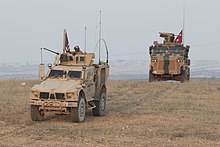
Many Syrians still hope for a better future for their country, with justice, peace, prosperity and freedom for all marking their common life. More inclusive and representative governance structures are widely sought. Support from the US for this is clear. As one person we met said, ‘There should be an American support for the Syrian people’s demands and reforming the current governance structure so that it is able to prevent the resurgence of ISIS and can confront Iran and Russia in case they want to control us.’ At present, however, Syria’s future remains uncertain, particularly with an expansion of Iranian militias west of the Euphrates and perceived decline in US interest. As one interviewee summarised the situation,
The future is very uncertain, with the Iranian militias expanding west of the Euphrates while American policy is retreating due to the current administration’s lack of interest in the reality, particularly in Syria overall. We hope to expel the militias from Al-Bukamal[16] specifically and cut off the head of the snake that stretches to Baghdad, Damascus, and Beirut. Once this city is liberated, thousands of Deir Ezzor residents will return, rely on their lands, and live with dignity. The hoped-for future is one without normalization with Assad and Russia, selling the blood of Syrians that has been shed since 2011.
Hope remains strong to return to normalcy and self-sufficiency. ‘The hope is to return to my town occupied by Iran and to have a more representative leadership instead of Kurdish dominated one’, said another person. Seeking ways to support and justify such hopes should be central to US and international engagement with Syria in coming decades.
Dr Haian Dukhan (Oxford House Associate) and Omar Abu Layla[17]
As in all Oxford House Briefings, every effort is made to attribute images where information is available.
[1] The operation to confront ISIS in Syria, Iraq and, by extension, Libya was code named ‘Operation Inherent Resolve’. Though a coalition initiative, 70% of airstrikes during the operation were undertaken by the US (+ ca. 20% by the UK and the remainder by other allies, viz. France, Turkey, Canada, the Netherlands, Denmark, Belgium, Saudi Arabia, the United Arab Emirates, Australia and Jordan).
[2] By February 2021, there were only 900 US troops left in Syria.
[3] By the time IS was defeated in March 2019, the Pentagon ca. 110,000 sq. km. and 7.7m people had been liberated from the IS ‘caliphate’.
[4] Cf. the Syrian Democratic Force (SDF) is a diverse coalition of ethnic militias and rebel groups across NE Syria, including the Jazira Region and Deir ez-Zor Governate. With an estimated 200,000 troops in 2021, it acts as the military arm of AANES (the Autonomous Administration of North and East Syria).
[5] On this, see e.g., O. Hossino, ‘Our Confused Syria Debate’, Hoover Institute, 17 December 2019: https://www.hoover.org/research/our-confused-syria-debate; accessed 4 July 2024; C. Lister, ‘America Is Planning to Withdraw From Syria—and Create a Disaster’, Foreign Policy, 24 January 2024: https://foreignpolicy.com/2024/01/24/america-is-planning-to-withdraw-from-syria-and-create-a-disaster; accessed 4 July 2024; G. Cafiero, ‘Debating the US presence in Syria: The ISIS factor’, Responsible Statecraft, 21 February 2024: https://responsiblestatecraft.org/us-troops-in-syria; accessed 4 July 2024.
[6] Cf. also the legal challenge to the US presence in Syria, A. Langlois, ‘Washington Cannot Justify Its Troop Presence in Syria’, Newsweek Magazine, 28 February 2024: https://www.newsweek.com/washington-cannot-justify-its-troop-presence-syria-opinion-1873971; accessed 4 July 2024.
[7] The US Department of Defence reported that in November 2021 there were 900 troops in Syria. The Al-Tanf (Arabic: التَّنْف) base in the Homs Governorate (close to the Iraq border) remains a key centre for US operations.
[8] Cf. In September 2021, the UN reported 350,209 people killed in the Syrian civil war between March 2011 and March 2021, while admitting this was ‘certainly an under-count’. Other estimates indicate nearer 580,000 killed to May 2021 and 618,000 by March 2024.
[9] Cf. The UN Commission on Human Rights (UNCHR) described ISIS as seeking to ‘subjugate civilians under its control and dominate every aspect of their lives through terror, indoctrination, and the provision of services to those who obey.’ In 2014, an estimated 8m people were under ISIS control. Off-shoots of ISIS continue to wreak havoc worldwide, with ISIS-Khorasan (ISIS-K), which claimed responsibility for the terrorist attack in Moscow in March 2024, praising their Islamist brethren in the Caucasus for attacking two synagogues and two Orthodox Churches in Derbent and Makhachkala (two of the largest cities) in the Russian Republic of Dagestan on 23 June 2024 in which 21 people were killed and at least 46 injured.
[10] Cf. the largest city in eastern Syria.
[11] N.B. to put this in context: relief agencies estimate 69% of the Syrian population (viz. 14.5m) was in a state of ‘poverty’ in 2022, with 1 in 4 in ‘extreme poverty’. The devastating earthquake in the north of the country in February 2023 made matters even worse. On this, see ‘Syria Economic Monitor, Spring 2024: Conflict, Crises, and the Collapse of Household Welfare’, Relief Web, 24 May 2024: https://reliefweb.int/report/syrian-arab-republic/syria-economic-monitor-spring-2024-conflict-crises-and-collapse-household-welfare; accessed 5 July 2024; also, the IRC press release, ‘Syria: Deepening economic crisis compounds conflict misery…’, 14 March 2024: https://www.rescue.org/press-release/syria-deepening-economic-crisis-compounds-conflict-misery-syria; accessed 5 July 2024.
[12] N.B. it is important to see this in the larger context of protracted US sanctions against Syria: https://www.state.gov/syria-sanctions; accessed 6 July 2024.
[13] For the announcement of further US aid in June 2023, see https://www.usaid.gov/news-information/press-releases/jun-15-2023-united-states-announces-920-million-additional-humanitarian-assistance-people-syria#:~:text=The%20United%20States%20remains%20the,the%20start%20of%20the%20crisis; accessed 6 July 2024.
[14] On this, see the Relief Web report, ‘Syria: States supporting SDF share responsibility for horrific human rights violations’, 3 August 2022: https://reliefweb.int/report/syrian-arab-republic/syria-states-supporting-sdf-share-responsibility-horrific-human-rights-violations; accessed 5 July 2024; also, Amnesty International’s report, ‘Syria: Mass death, torture and other violations against people detained in aftermath of Islamic State defeat’, 17 April 2024: https://www.amnesty.org/en/latest/news/2024/04/syria-mass-death-torture-and-other-violations-against-people-detained-in-aftermath-of-islamic-state-defeat-new-report; accessed 5 July 2024.
[15] On the roots of current debate about the return of ISIS, see e.g., ‘Averting an ISIS resurgence in Iraq and Syria’, Crisis Group, 11 October 2019: https://www.crisisgroup.org/middle-east-north-africa/eastern-mediterranean/syria/207-averting-isis-resurgence-iraq-and-syria; accessed 6 July 2024.
[16] Cf. Al-Bukamal or Abu Kamal is a city on the Euphrates river in the Deir ez-Zor Governorate of eastern Syria near the border with Iraq.
[17] Omar Abu Layla is affiliated to MPP Princeton and is Director of DeirEzzor 24 Media Network (https://deirezzor24.net/en). He is a consultant, and regular contributor to media outlets, on local and social issues relating to the Syrian conflict.

